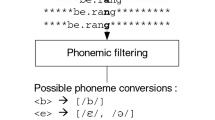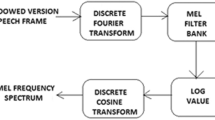Abstract
An automatic syllabification, decomposing a word into syllables, is an important part in an automatic speech recognition (ASR) that uses both syllable-based acoustic and language models. It can be performed to either phoneme or grapheme sequences. The phonemic syllabification is more complex than the other since it requires a grapheme-to-phoneme conversion (G2P) as a previous process. It generally gives a high accuracy for many formal words but its accuracy may decrease for person-names. In contrast, the graphemic syllabification is simpler and more potential to be applied for person-names. This research focuses on developing a model of graphemic syllabification using a combination of phonotactic rules and Fuzzy k-nearest neighbour in every Class (FkNNC). The phonotactic rules are designed to find some deterministic syllabification points while FkNNC, as a statistical classifier, is expected to search the remaining stochastic syllabification points. A recovery procedure is proposed to correct the wrong syllabification points produced by FkNNC. Fivefold cross-validating on a dataset of 50k formal words, selected from the great dictionary of the Indonesian language, shows that the proposed model gives syllable error rate (SER) of 2.48% and the proposed recovery procedure reduces the SER to be 2.27%, which is higher than that produced by the phonemic syllabification (only 0.99%). But, this model is capable of handling a dataset of 15k high variance person-names with SER of 7.45% and the proposed recovery procedure reduces the SER to be 6.78%.









Similar content being viewed by others
References
Adsett, C. R., Marchand, Y., & Kešelj, V. (2009). Syllabification rules versus data-driven methods in a language with low syllabic complexity: The case of Italian. Computer Speech and Language, 23, 444–463. https://doi.org/10.1016/j.csl.2009.02.004.
Alwi, H., Dardjowidjojo, S., Lapoliwa, H., & Moeliono, A. M. (1998). Tata Bahasa Baku Bahasa Indonesia [The Standard Indonesian Grammar] (3rd ed.). Jakarta: Balai Pustaka.
Bartlett, S., Kondrak, G., & Cherry, C. (2008). Automatic syllabification with structured SVMs for letter-to-phoneme conversion. In Proceedings of Human Language Technologies: The 2008 Annual Conference of the North American Chapter of the Association for Computational Linguistics, pp. 568–576, Columbus.
Bartlett, S., Kondrak, G., & Cherry, C. (2009). On the syllabification of phonemes. In Proceedings of Human Language Technologies: The 2009 Annual Conference of the North American Chapter of the Association for Computational Linguistics, pp. 308–316. Boulder. https://doi.org/10.3115/1620754.1620799.
Chaer, A. (2009). Fonologi Bahasa Indonesia [Indonesian Phonology]. Jakarta: Rineka Cipta.
Janakiraman, R., Kumar, J.C., & Murthy, H.A. (2010). Robust syllable segmentation and its application to syllable-centric continuous speech recognition. In National Conference on Communications (NCC), pp. 1–5, Joint Telematics Group of IITs & IISc, Chennai. https://doi.org/10.1109/NCC.2010.5430189. http://ieeexplore.ieee.org/lpdocs/epic03/wrapper.htm?arnumber=5430189.
Keller, J. M., Gray, M. R., & Givens, J. A. (1985). A Fuzzy K-Nearest Neighbor Algorithm. EEE Transactions on Systems Man and Cybernetics, 15(4), 580–585. https://doi.org/10.1109/TSMC.1985.6313426.
Kristensen, T. (2000). A neural network approach to hyphenating Norwegian. In Proceedings of the IEEE-INNS-ENNS International Joint Conference on Neural Networks, pp. 148–153, Vol. 2, IEEE. https://doi.org/10.1109/IJCNN.2000.857889.
Majewski, P. (2008). Syllable Based Language Model for large vocabulary continuous speech recognition of polish. In P. Sojka, A. Horák, I. Kopeček, & K. Pala (Eds.), Text, Speech and Dialogue (pp. 397–401). Heidelberg: Springer.
Marchand, Y., Adsett, C.R., & Damper, R.I. (2007). Evaluating automatic syllabification algorithms for English. In Proceedings of the 6th International Speech Communication Association ISCA Workshop on Speech Synthesis, pp. 316–321.
Mohanty, S. (2011). Phonotactic model for spoken language identification in indian language perspective. International Journal of Computer Applications, 19(9), 18–24.
Suyanto, S., Hartati, S., & Harjoko, A. (2016). Modified grapheme encoding and phonemic rule to improve PNNR-based Indonesian G2P. International Journal of Advanced Computer Science and Applications (IJACSA), 7(3), 430–435.
Suyanto, S., Hartati, S., Harjoko, A., & Compernolle, D. V. (2016). Indonesian syllabification using a pseudo nearest neighbour rule and phonotactic knowledge. Speech Communication, 85, 109–118. https://doi.org/10.1016/j.specom.2016.10.009.
Tian, J. (2004). Data-driven approaches for automatic detection of syllable boundaries. In Proceedings of the International Conference on Spoken Language Processing (ICSLP), pp. 61–64
Acknowledgements
We would like to thank Forum Alumni Universitas Telkom (FAST) for the dataset of 15k high variance person-names.
Funding
This work is supported by Forum Alumni Universitas Telkom (FAST).
Author information
Authors and Affiliations
Corresponding author
Rights and permissions
About this article
Cite this article
Parande, E.A., Suyanto, S. Indonesian graphemic syllabification using a nearest neighbour classifier and recovery procedure. Int J Speech Technol 22, 13–20 (2019). https://doi.org/10.1007/s10772-018-09569-3
Received:
Accepted:
Published:
Issue Date:
DOI: https://doi.org/10.1007/s10772-018-09569-3




